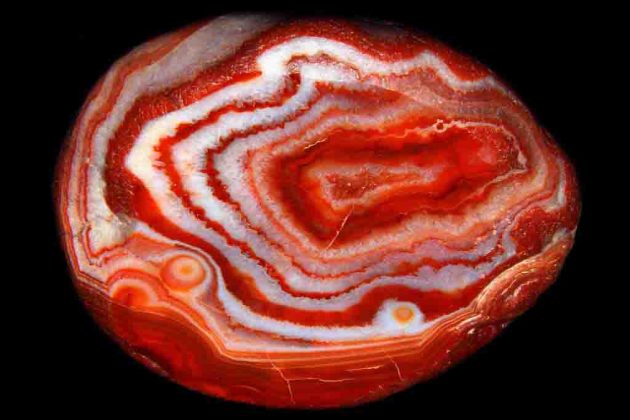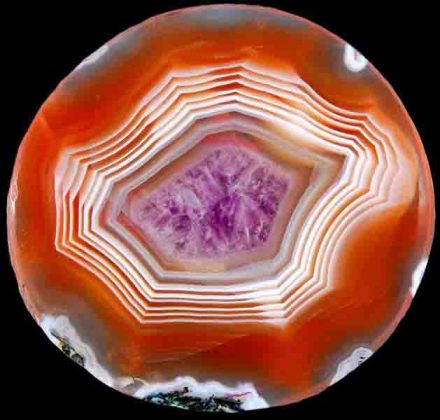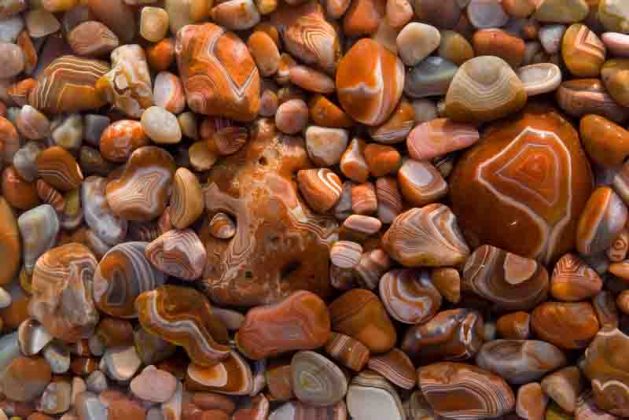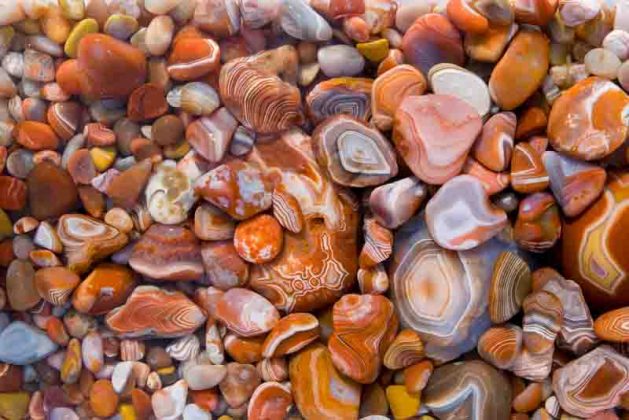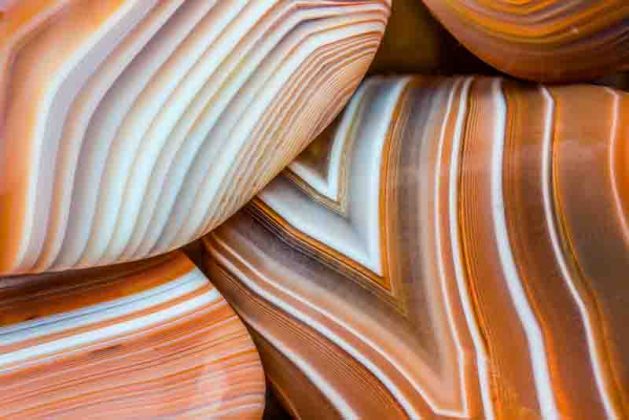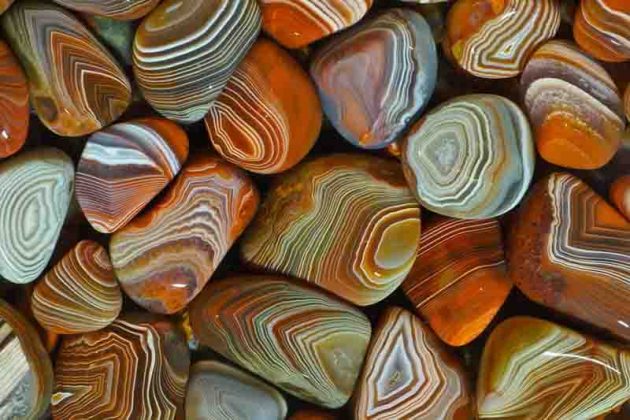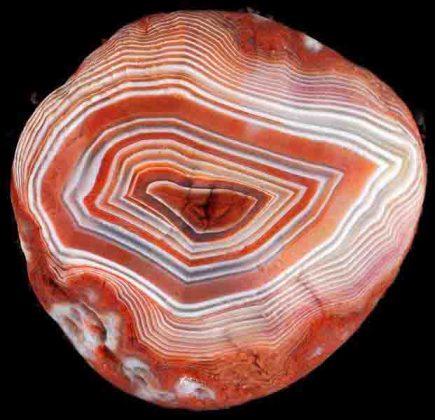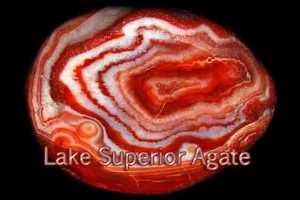
What is Lake Superior agate?
The Lake Superior agate is a type of agate stained by iron and found on the shores of Lake Superior. Its wide distribution and iron-rich bands of color reflect the gemstone’s geologic history in Minnesota, Wisconsin, and Michigan. In 1969 the Lake Superior agate was designated by the Minnesota Legislature as the official state gemstone.
The Lake Superior agate was selected because the agate reflects many aspects of Minnesota. It was formed during lava eruptions that occurred in Minnesota about a billion years ago. The stone’s predominant red color comes from iron, a major Minnesota industrial mineral found extensively throughout the Iron Range region. Finally, the Lake Superior agate can be found in many regions of Minnesota as it was distributed by glacial movement across Minnesota 10,000 to 15,000 years ago.
The Lake Superior agate is noted for its rich red, orange, and yellow coloring. This color scheme is caused by the oxidation of iron. Iron leached from rocks provided the pigment that gives the gemstone its beautiful array of color. The concentration of iron and the amount of oxidation determine the color within or between an agate’s bands. There can also be white, grey, black and tan strips of color as well.
The gemstone comes in various sizes. The gas pockets in which the agates formed were primarily small, about 1 cm in diameter. A few Lake Superior agates have been found that are 22 cm in diameter with a mass exceeding 10 kilograms. Very large agates are extremely rare.
The most common type of Lake Superior agate is the fortification agate with its eye-catching banding patterns. Each band, when traced around an exposed pattern or “face,” connects with itself like the walls of a fort, hence the name fortification agate.
A common subtype of the fortification agate is the parallel-banded, onyx-fortification or water-level agate. Perfectly straight, parallel bands occur over all or part of these stones. The straight bands were produced by puddles of quartz-rich solutions that crystallized inside the gas pocket under very low fluid pressure. The parallel nature of the bands also indicates the agate’s position inside the lava flow.
Probably the most popular Lake Superior agate is also one of the rarest. The highly treasured eye agate has perfectly round bands or “eyes” dotting the surface of the stone.
How Lake Superior agate formed?
More than a billion years ago, the North American continent began to split apart along plate boundaries. Magma upwelled into iron-rich lava flows throughout the Midcontinent Rift System, including what is now the Minnesota Iron Range region. These flows are now exposed along the north and south shores of Lake Superior. The tectonic forces that attempted to pull the continent apart, and which left behind the lava flows, also created the Superior trough, a depressed region that became the basin of Lake Superior.
The lava flows formed the conditions for creation of Lake Superior agates. As the lava solidified, water vapor and carbon dioxide trapped within the solidified flows formed a vesicular texture (literally millions of small bubbles). Later, groundwater transported ferric iron, silica, and other dissolved minerals passed through the trapped gas vesicles. These quartz-rich groundwater solutions deposited concentric bands of fine-grained quartz called chalcedony, or embedded agates.
Over the next billion years, erosion exposed a number of the quartz-filled, banded vesicles—agates—were freed by running water and chemical disintegration of the lavas, since these vesicles were now harder than the lava rocks that contained them. The vast majority, however, remained lodged in the lava flows until the next major geologic event that changed them and Minnesota.
During the ensuing ice ages a lobe of glacial ice, the Superior lobe, moved into Minnesota through the agate-filled Superior trough. The glacier picked up surface agates and transported them south. Its crushing action and cycle of freezing and thawing at its base also freed many agates from within the lava flows and transported them, too. The advancing glacier acted like an enormous rock tumbler, abrading, fracturing, and rough-polishing the agates.
Where to find Lake Superior agates?
The Superior lobe spread agates and other debris throughout northeastern and central Minnesota and extreme northwestern Wisconsin.
Glaciers dispersed Minnesota’s official rock around the state into various settings where hikers, campers, hunters, and outdoor enthusiasts can readily collect them. Many beautiful specimens have been found in gravel banks along rivers and streams.
Popular hunting grounds include the Mississippi River and waters that empty into Lake Superior along the North Shore. The beaches along Lake Superior and hundreds of other lakes have produced many gems. Virtually any place with exposed gravel and rocks offers the chance of finding Lake Superior agates.
How to identify Lake Superior agate?
The following characteristics will help you identify agates in the field.
- Band planes along which the agate has broken are sometimes visible, giving the rock a peeled texture. It appears as though the bands were partially peeled off like a banana skin.
- Iron-oxide staining is found on nearly all agates to some degree, and generally covers much of the rock. Such staining can be many different colors, but the most common are shades of rust-red and yellow.
- Translucence is an optical feature produced by chalcedony quartz, the principal constituent of agates. The quartz allows light to penetrate, producing a glow. Sunny days are best for observing translucence.
- A glossy, waxy appearance, especially on a chipped or broken surface, is another clue.
- A pitted texture often covers the rock surface. The pits are the result of knobs or projections from an initial layer of softer mineral matter deposited on the wall of the cavity in which the agate formed. Later, when the quartz that formed the agate was deposited in the cavity, these projections left impressions on the exterior.


